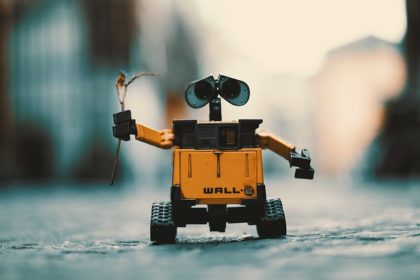
 )
)A few years ago, I received a letter informing me that I needed to get new, color-coded waste barrels because our township was implementing a new robotic waste collection program. My inner tech geek was excited, although I’m not really sure what I expected. I knew autonomous vehicle technology was not (and still is not) at the point where a driverless truck would just be let loose on the streets to collect trash and recycling. The high-tech scenario was such a vehicle with humans onboard to monitor and be a safety backup. I think the lowest-tech scenario I expected was still one where a robotic arm would use computer vision to decide which barrel to pick up and empty, hence the need for color-coding. In any case, I was mildly disappointed when all it turned out to be was a truck with a mechanical arm, not fundamentally different from the trucks that have been emptying dumpsters for years. The color lids are simply so the human driver knows where to stop the truck.
I started thinking about those trucks and those drivers again when I was reflecting on the topic of automation in work and how humans are being replaced at their jobs by artificial intelligence but also machines more broadly. That’s the subject of one of the articles on AI and Christianity that I promised to get back to. The series, co-authored by ESN contributor J. Nathan Matias, has completed the articles laid out in the introduction, and so I thought it was time to revisit them. I commend the whole series to you; the articles are brief introductions to a variety of topics in artificial intelligence and how they intersect with traditional Christian thinking and concerns, along with resources for more details. Over the next few weeks, I want to interact with some of them and carry the conversation forward.
What occurred to me as I revisited my neighborhood waste removal trucks was the way we frame the conversation. I am reasonably certain the task used to be a two-person operation and now requires just one. Thus at least in the customer-visible portion, a job was lost. We typically say that person was replaced by a machine, in this case a robotic arm. Would it change the conversation if instead we said the remaining employee was provided with an enhancement device that allowed them to do the job alone? Or to put it another way, the displaced employee wasn’t replaced by a machine but a cyborg. On the one hand, this perhaps restores some dignity to that displaced worker by removing the suggestion that their contribution could be reduced to an unthinking mechanical process. On the other hand, it might foster more resentment towards the remaining nondisplaced employee who was granted superhuman abilities.

 )
)Now admittedly AI plays a minimal role in my example, making it easier to view the new truck as an extension of the driver rather than an entity in its own right. Still, as Matias et al observe, near-to-midterm applications of AI in the workplace will involve humans in the loop in some capacity. And AI is still a long way from developing anything we might recognize as conscious and cognitively or morally equivalent to a human. Thus we might think of stock-trading bots as enhancing devices that allow the brokers who devise the trading rules the bots follow to apply those rules more quickly than the broker could by hand. Or the chat bots deployed to do front line customer service simply make it possible for human customer service agents to serve more customers at a time. Considered in this way, they are no different than, say, a telephone which allows a salesperson to reach more clients than if they had to travel in person to meet each one.
The AI and Christianity article on work also mentions the possibility of AI monitoring in the workplace (already car makers are testing technology that makes sure you are paying attention to the road for example) and AI-based management where an AI agent oversees or coordinates the work of distributed humans. Feeling like you are reporting to a machine carries its own potential for indignity. Yet if we view these AI tools as devices that allow us to be our own boss or at least enhance our own autonomy, perhaps that might provide a dignity boost instead.
Of course, describing AI and other workplace innovations as enhancements and extensions of their human operators still leaves us with the issue of who gets to benefit from these enhancements and who does not. We might cynically categorize them all as device to enhance the ability of corporate owners to extract money from their companies and employees. We can reflect on how the choices are made about which enhancements to implement and which tasks to leave to unaided humans. We can consider how to enable employees to make those decisions for themselves, opting to be enhanced or not in light of how that might effect their fellow employees. I think that’s an interesting variation on the Protestant work ethic — if I and everyone else who is able has a moral obligation to work productively, are we morally obligated to work as efficiently as possible even at the expense of someone else’s opportunity to work? The story of Ruth comes to mind as a relevant point of reference. I suppose in turn that raises the question of whether work is actually a limited resource, as the phrasing implies, or if there will always be plenty to do no matter how much I personally accomplish.
This is a relatively new area of exploration for me. Perhaps you have already had these thoughts about being replaced by machines vs enhanced humans, or know of work in that area. Perhaps I’m overlooking some way in which I’m oversimplifying, or some reason why this is an unhelpful way of framing the conversation. I’m curious to hear your feedback and how you approach the topic of work, machines, and artificial intelligence, including what it would look like for you to get enhancements for doing your job better or for someone else to get enhancements to do your job for you.
Andy has worn many hats in his life. He knows this is a dreadfully clichéd notion, but since it is also literally true he uses it anyway. Among his current metaphorical hats: husband of one wife, father of two teenagers, reader of science fiction and science fact, enthusiast of contemporary symphonic music, and chief science officer. Previous metaphorical hats include: comp bio postdoc, molecular biology grad student, InterVarsity chapter president (that one came with a literal hat), music store clerk, house painter, and mosquito trapper. Among his more unique literal hats: British bobby, captain’s hats (of varying levels of authenticity) of several specific vessels, a deerstalker from 221B Baker St, and a railroad engineer’s cap. His monthly Science in Review is drawn from his weekly Science Corner posts — Wednesdays, 8am (Eastern) on the Emerging Scholars Network Blog. His book Faith across the Multiverse is available from Hendrickson.

Leave a Reply